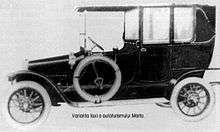Astra Automobile & Waggon Factory
The Astra Automobile & Waggon Factory was an Austro-Hungarian manufacturer of vehicles, seated in Arad.
History
Weitzer János Rt.

Johann Weitzer (born in 1832, died in 1902) was an Austrian skilled blacksmith and businessman. In 1854, he founded his own workshop, which expanded quickly, even producing vehicles for the construction of the Suez Canal. The main products were railway waggons and arms for Austrian use.[1] In 1872, he transformed his enterprise into a joint-stock company, which later merged with two other companies to Simmering-Graz-Pauker. In 1891, he founded, as a subsidiary of the Austrian company in the Hungarian part of Habsburg Monarchy, in Arad the Weitzer János Gép,- Waggongyár és Vasöntöde Részvénytársaság, (John Weitzer Engine- & Waggon-building & Iron Casting Joint-stock Company). It produced locomotives, railway waggons, tramcars (such as 17 items for Temesvár/Timișoara), and, since 1903, Europe's first successful series of railmotors.
MARTA

The automobiles manufactured in Arad was a licensed production of Westinghouse 150 cars from 1909 to 1912. In 1912 the plant was taken over by Austro-Daimler and renamed to MARTA, the acronym for Magyar Automobil Részvény Társaság Arad (Hungarian Automobile Joint-stock Company Arad). After the edition auf 500 automobiles, civil production ceased in 1914, due to World War I.
Descendants
In 1921, after the dissolution of the Austria-Hungary, the two companies, now located in Romania, merged to form Astra Automobile & Waggon factory (Romanian: Fabrica de automobile și vagoane Astra).[2] This company from 1922 to 1926 also manufactured some automobiles[3] and lorries, but the main production were rail vehicles. After World War II, it was nationalized and became Europe's biggest manufactorer of freight cars, as Întreprinderea de Vagoane Arad (IVA).
With privatization, in 2000, the company was split into specialists for the various branches. The production of freight cars, Astra Vagoane Arad, was sold to Trinity Industries, which sold it to International Railway Systems (IRS), seated in Luxemburg, but mainly based on plants in eastern Europe.[4] In November 2010, Astra Vagoane Arad and the two other Romanian subsidiaries of IRS went bankrupt,[5] and reformed under the name Astra Rail Industries (ARI) in 2012. In 2016, The Greenbrier Companies and ARI agreed to form a joint venture, 75% owned by Greenbrier. The new business was to be named Greenbrier-Astra Rail.
The two other descenders of Astra Automobile & Waggon factory, Astra Bus and Astra Vagoane Călători (Astra Passenger Cars), are still operating.[6]
References
- ↑ "Johann Weitzer". City of Graz (in German).
- ↑ "Arader Zeitung" (PDF) (in German). 1 May 1921. p. 2. Archived from the original (PDF) on 2005-03-25. (note in German on the merging of Weitzer and MARTA)
- ↑ Georgano 1982, p. 59.
- ↑ "International Railway Systems (IRS) übernimmt Europageschäft von Trinity" [Astra Vagoane Arad taken over by IRS]. Eurailpress (in German). 1 August 2006.
- ↑ "Note on the insolvence of the Romanian subsidiaries of IRS". debizz (in German). Archived from the original on July 6, 2013.
- ↑ "SC Astra Vagoane Călători SA". Iris Certification.
- Georgano, George Nick (1982). The New Encyclopedia of Motorcars, 1885 to the Present (3rd ed.). New York: Dutton Press. ISBN 0-525-93254-2.
- Linz, Harald; Schrader, Halwart (2008). Die Internationale Automobil-Enzyklopädie (in German). München: United Soft Media Verlag. ISBN 978-3-8032-9876-8.
External links
- cimec.ro, Primele automobile române fabricate în România (in Romanian)
- kmarket.ro, Astra Vagoane Arad (in Romanian)